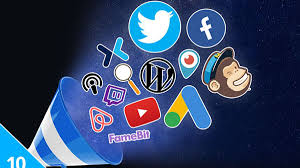
Every year seems to bring a new set of marketing trends, those “can’t miss” opportunities that scream out for attention. If we were to hop on every trends, we’d certainly grow dizzy from exhaustion. Nevertheless, there are some trends that we’d be foolish not to recognize.
As we begin the last chapter of 2017, many companies are still working through the creation of a bona fide content marketing strategy. If that’s you, here are some hints: Native advertising continues to be the gateway drug to success, and mobile continues to be the flavor of every month.
That said, Smart Insights reports that content marketing is THE single most important technique for driving incremental sales in 2017. In an industry that’s all about experimentation, some key trends stand out.
Here are 10 content marketing trends that everyone is talking about.
1. Brands Will Continue to Invest in Original Content
Recently, it became public knowledge that tech giant Apple is planning to invest of $1 billion in original content. Though some gossip states that Apple is making this move to take on Netflix, we believe there’s more on Apple’s mind than video streaming. As competition in this space heats up, brands need to stay relevant. Valuable, original programming can help companies grow an audience and keep current customers satisfied.
Google is also purchasing original content from media companies and brands to fill in content gaps, while Facebook is investing huge amounts of capital on original video. Not to be outline, online shopping giant Amazon will perhaps be the largest investor of all. Though the consequences remain to be seen, one thing is for sure: content marketing is taking the spotlight.
2. Transparency Will Reign King (or Queen)
Consumers are becoming increasingly desensitized. We want — and often expect — companies to be transparent, authentic, and dedicated to giving back. After all is said and done, however, many consumers are reporting frustration with brand advertising, environmental claims, charitable contributions, and corporate support for various causes. Though such efforts have been successful for some brands, this type of promotion is increasingly being perceived as desperate or dishonest.
Moving forward, brands need to focus on transparency and disclosure to close this gap as much as possible. Enter: Influencer Marketing.
Yet, working with influencers can be sticky. The Federal Trade Commission continues to take measures to protect consumers from companies who aren’t transparent enough, including work with influencers. Take what happened with Machinima. In 2015, the FTC slapped Machinima, a YouTube gaming network, with a warning for not disclosing paid endorsements to YouTube influencers.
And this is far from the only instance. A quick Google search shows that a lack of disclosure and transparency have caused trouble for many brands. To build (and maintain) the trust of your audience, the next phase of influencer marketing and branded content needs to ensure that every piece of content created is transparent.
3. Content Marketing Budgets Will Continue to Increase
Across the globe, companies are spending huge amounts of money on content marketing. What serves as great news for content marketers also presents challenges for businesses with a limited staff. This is propelling the likelihood that companies turn to freelance writers and others who can produce content for a price.
4. Content Marketing Duties Continue to Overlap
Often, it’s difficult to determine exactly who is in charge of content within a company. Roles and duties shift within marketing departments and even in other areas of the business. PR and communications may have separate content creators, social media managers, and other writers that are not integrated with the official content team, leaving no one really in charge. Such disarray can lead to a very disjointed content strategy.
5. Internet of Things Will Take Content Off-Screen
Customers are no longer limited to the screen in the way that they view content. Although different content formats have long been available, the IoT has made it so content is interwoven into our lives in brand new ways. Consider how we current interact with technology, such as Apple’s Siri. When users speak, Siri responds with call-and-response content wherever and whenever they need it. Alexa, Amazon’s voice service, is becoming a digital doorway to content as well.
Many organizations already use Alexa to share content with their audience beyond a laptop, tablet, or cell phone screen. For example, the American Heart Association uses Alexa to provide details about performing CPR, including step-by-step information on how to perform the process in an emergency situation. This content is further embellished with information about warning signs of a stroke and heart attack.
With IoT, most content is becoming digital. Beacon-based proximity marketing, sensors, device pairing, and other features usher in the opportunity for marketers to invest in endless types of content interaction. This type of highly targeted content can help you reach your audience at the right place and at the right time.
6. Pre-Recorded Video is So… Yesterday
It isn’t exactly time to write the obituary for pre-recorded video, yet it is being overshadowed by live video. According to Buffer, 80 percent of marketing respondents to a 2016 survey want to create more video content, with 42 percent specifying live video as their preference.
While live video really exploded in 2017, we predict that it’ll become even more mainstream in 2018. According to Facebook, users spend three times more time watching live videos than videos that are pre-recorded. More, they comment 10 times as often during live videos. A Livestream survey confirmed this, with 80 percent of respondents indicating a preference for live video over reading a blog post. This presents modern-day marketing specialists with a unique chance to hop on the live video bandwagon before competitors do.
7. Blurred Lines
If you look at how content has changed over the past decade, you’ll notice that it has evolved outside of its original “container” of owned media. As social media expands, as well as the ways we interact with and engage audiences, the lines between owned, earned, and paid begin to blur so that they’re almost indiscernible from one another. Content can no longer be confined to these silos.
With the entire buyer’s journey in mind, the content shifts to take on the form of all three approaches. This underscores the importance of each form working seamlessly together to support a company’s growth strategy. That means you must adjust your internal and external teams to handle content development, deployment, and promotion.
8. Strategic Documentation
Ask a marketing specialist about the effectiveness of content marketing, and chances are he or she will be able to pinpoint what makes the cogs turn effectively. That’s because companies are becoming laser-focused on developing thoughtful content marketing strategies.
In 2015, only 32 percent of marketers had a documented content marketing strategy. The following year, this grew to 37 percent. This year, however, the number has ballooned to well over 40 percent. Our prediction for 2018, then, is that developing an effective, efficient strategy will be a job expectation.
To remain competitive in the upcoming year, what strategies will you include? You may want to consider more targeted content, expanded content, more efficient content creation, or other elements that will help you foster greater growth.
9. Interactive Visual Content
We all know that live video is engaging and responsive, yet there’s another type of visual content that allows you to craft an entirely different experience for your audience.
Virtual reality.
VR offers new opportunities for content marketing, as well as customer engagement. Shopify, for instance, has taken this to heart and developed a VR app that allows online shoppers to customize clothing from the comfort of home.
International Data Corporation reports that, based on sales and forecast models, revenue for augmented reality will grow from just over $5 billion in 2016 to more than $160 billion by 2020. Revenue forecasts from Digi-Capital are equally optimistic, reporting an estimated growth to $108 billion by 2021.
While the prospect of virtual reality may seem daunting, it will likely be worthwhile for anyone willing to give it a go. Forbes Global shows that up to 30 percent of consumer-facing brands will experiment with virtual reality marketing by the end of this year.
Keep in mind that it isn’t solely for consumer advertising and marketing, however. Consider what the Golden State Warriors did when they wanted to recruit Kevin Durant to the team roster. Using content marketing in VR, they immersed him in the “Warrior’s Experience,” thereby placing him courtside at Oracle Arena as well as in the thick of talks with coach Steve Kerr in the locker room.
10. Distribution, Distribution, Distribution
While most marketers recognize how instrumental content is for companies now, what still remains uncertain is the means of which content is distributed. And though there are countless other blogs, newsletters, and email campaigns out there, the sure way you’ll have your message heard above the rest is through optimum content distribution.
If you want the attention of the 2.789 billion active social media users, you need to adopt a strategic distribution plan. Smart brands are going to make investments in not only acquiring content, but in distributing it strategically through multi-channel approaches as 2018 unrolls.



